The Cholesterol Medicine Market is estimated to be valued at USD 35.5 billion in 2025 and is projected to reach USD 53.5 billion by 2035, registering a compound annual growth rate (CAGR) of 4.2% over the forecast period.
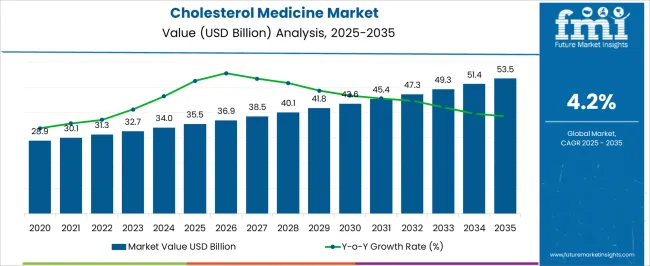
| Metric | Value |
|---|---|
| Cholesterol Medicine Market Estimated Value in (2025 E) | USD 35.5 billion |
| Cholesterol Medicine Market Forecast Value in (2035 F) | USD 53.5 billion |
| Forecast CAGR (2025 to 2035) | 4.2% |
The Cholesterol Medicine market is advancing steadily, primarily due to the global rise in cardiovascular diseases and lifestyle-related health risks. The increasing prevalence of obesity, sedentary habits, and unhealthy dietary patterns has elevated cholesterol levels across large population groups, driving the demand for effective therapeutic options. Government and private healthcare initiatives promoting preventive care and cholesterol monitoring are also shaping the market landscape.
Furthermore, advances in drug discovery, particularly in lipid-lowering therapies and biologics, are expanding treatment options for patients resistant to traditional medications. A strong emphasis on clinical research, coupled with ongoing patent expirations, is fostering both branded and generic drug availability, improving accessibility worldwide. Growing awareness campaigns about cardiovascular risks and preventive treatments are further boosting patient adoption.
Digital health platforms are enabling greater adherence to medication regimens through reminders and real-time monitoring, strengthening outcomes With increasing healthcare expenditure, a rising geriatric population, and the growing burden of heart-related disorders, the Cholesterol Medicine market is expected to witness sustained expansion across both developed and emerging economies.
The cholesterol medicine market is segmented by product type, route of administration, distribution channel, and geographic regions. By product type, cholesterol medicine market is divided into HMG-CoA Reductase Inhibitors (Statins), Bile Acid Sequestrants, Fibrates, Niacin, Cholesterol Absorption Inhibitors, Omega-3 Fatty Acid, and Combination Medicines. In terms of route of administration, cholesterol medicine market is classified into Oral and Subcutaneous. Based on distribution channel, cholesterol medicine market is segmented into Hospital Pharmacy, Drug Stores, Retail Pharmacy, and E-commerce. Regionally, the cholesterol medicine industry is classified into North America, Latin America, Western Europe, Eastern Europe, Balkan & Baltic Countries, Russia & Belarus, Central Asia, East Asia, South Asia & Pacific, and the Middle East & Africa.
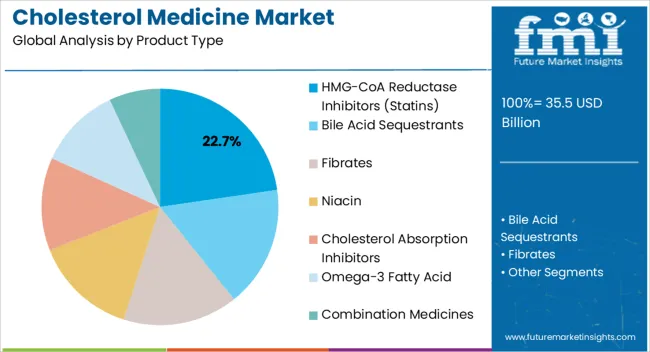
The HMG-CoA reductase inhibitors segment, commonly known as statins, is projected to account for 22.7% of the Cholesterol Medicine market revenue in 2025, making it a key product type. Statins are widely prescribed due to their proven effectiveness in lowering low-density lipoprotein cholesterol levels and reducing the risk of cardiovascular events. Their extensive use in both primary and secondary prevention of heart disease has strengthened their position in global treatment regimens.
The availability of multiple generic variants has significantly improved affordability and accessibility, especially in developing regions where cardiovascular diseases are rapidly increasing. Statins also benefit from well-established clinical evidence and physician trust, which ensures consistent prescribing patterns across healthcare systems. Ongoing research continues to explore combination therapies where statins are paired with other lipid-lowering agents, further enhancing therapeutic outcomes.
The strong presence of statins in national health guidelines and reimbursement frameworks reinforces their dominance As cardiovascular disease prevalence rises, statins are expected to remain a cornerstone therapy, supported by their cost-effectiveness and long history of clinical success.
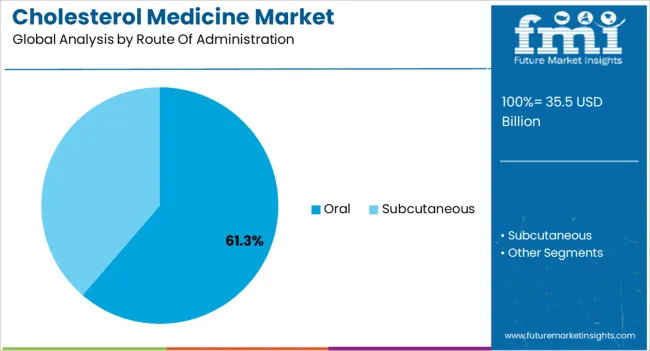
The oral route of administration segment is anticipated to capture 61.3% of the Cholesterol Medicine market revenue in 2025, positioning it as the leading delivery method. Oral formulations are favored due to their ease of use, patient convenience, and suitability for long-term therapy, which is often required in cholesterol management. Tablets and capsules allow for consistent dosing, improving adherence and reducing the risk of treatment discontinuation.
The wide range of oral cholesterol-lowering medications, including both branded and generic formulations, enhances their accessibility across diverse patient populations. Oral delivery also reduces the need for hospital visits or specialized administration techniques, making it cost-effective for healthcare systems. Technological advancements in formulation science are improving drug bioavailability and minimizing side effects, further encouraging adoption.
The oral route aligns with patient preference for non-invasive therapies, supporting higher compliance levels As cholesterol management typically requires lifelong treatment, the dominance of oral medications is expected to continue, reinforced by their affordability, reliability, and compatibility with evolving therapeutic approaches.
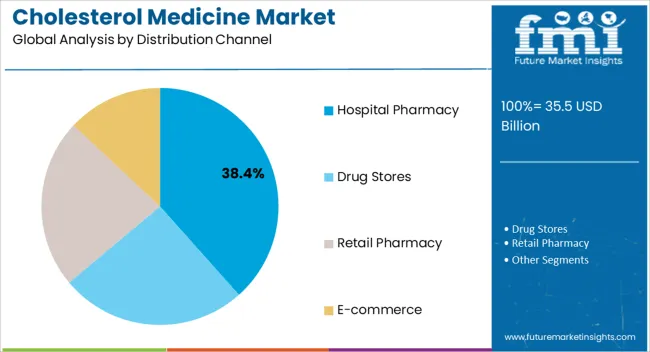
The hospital pharmacy segment is expected to hold 38.4% of the Cholesterol Medicine market revenue in 2025, emerging as a key distribution channel. Hospitals play a critical role in initiating treatment for patients diagnosed with cardiovascular conditions and related complications, which drives significant dispensing through hospital pharmacies. These pharmacies are often the first point of access for newly prescribed cholesterol-lowering drugs following inpatient or emergency care.
Strong regulatory compliance and direct procurement from manufacturers ensure drug authenticity and quality, which is critical for patient trust. Additionally, hospital pharmacies provide opportunities for patient counseling, ensuring better understanding of treatment regimens and improving adherence. The presence of specialized healthcare professionals allows for monitoring of potential drug interactions and adverse effects, enhancing patient safety.
With the rising prevalence of cardiovascular diseases, more patients are entering healthcare systems through hospitals, reinforcing their role in medicine distribution The segment also benefits from insurance and reimbursement linkages, which facilitate affordability for patients Consequently, hospital pharmacies are anticipated to remain a vital distribution channel within the Cholesterol Medicine market.
Cholesterol is white, waxy, fat deposit in the blood stream that is manufactured in the liver and released into the blood. A small amount of cholesterol is needed by the body to work efficiently. The body produces all the cholesterol needed for the production of hormones, vitamin D and the all the substance required for food digestion.
The main external source of cholesterol is found in the food we eat. Sufficient amount of cholesterol is vital for body function, but increased level of cholesterol may cause serious health problems. About 75% of cholesterol are produced by liver and other cells of the body. Cholesterol travels through blood stream in small packages known as the lipoprotein.
Two types of lipoprotein are present to carry cholesterol known as low-density lipoproteins (LDL) and high-density lipoproteins (HDL).Healthy level both lipoprotein are important for proper functioning of the body.
Low-density lipoproteins (LDL) are known as bad cholesterol as they get deposit in the arteries, causing chest pain, heart attack, stroke and other kidney and circulation problems.
High-density lipoproteins (HDL) are known as good cholesterol as it carries cholesterol from all parts of the body to the liver and liver finally removes the cholesterol out of the body. The more the HDL level, the healthy you are, proper exercise and diet help to maintain good cholesterol level.
Triglycerides, the third form of cholesterol that are present in high concentration in people who are diabetic or alcoholic, it increases the chances of cardiovascular diseases.
Lifestyle changes such as reduction in dietary saturated fat and cholesterol, with proper exercise and weight control, would help in lowering cholesterol level. Excess weight trends to increase LDL level, so regular exercise is necessary for lowering LDL level and increasing low high - density lipoproteins.
The level of cholesterol increases with age, nearly 1 in every 2 women in America suffers from high cholesterol level. Hypercholesterolaemia (high cholesterol) is one of the major cause of death in the world, about 2.6 million death occur per year worldwide.
According to world health organization, in the European Union five biggest countries - Germany, France, Italy, Spain and UK, 133 million people suffer from bad cholesterol. People with high level of blood cholesterol have the greater chance of developing heart diseases as plaque (made up of fat, calcium, cholesterol, and other substances found in the blood) gets deposit inside the coronary arteries.
Nowadays, a number of cholesterol-lowering medicines are available in a market. Statins are mostly used as the standard therapy in the treatment of hypercholesterolemia.
There are other alternative medicines and combined therapy available with both oral and injectable formulations in the market. According to the USA Centers for Disease Control and Prevention, in USA about 73 million adults suffer from low-density lipoprotein.
Cholesterol level varies by race, sex and ethnicity. Approximately 31 million Americans have total cholesterol level more than 240 mg/dL. Rising prevalence of cardiovascular diseases and new product launch are expected to drive the global cholesterol medicine market.
Based on the Product type, the global cholesterol medicine market is segmented into HMG-CoA Reductase Inhibitors (Statins), bile acid sequestrants, fibrates, niacin, cholesterol absorption inhibitors, omega-3 fatty acid, combination medicines.
Statins are mostly used as they are most effective drugs for lowering cholesterol, so statin is the leading segment, among product type in the global cholesterol medicine market and is expected to grow at the high rate during the forecast period. Based on the route of administration, the global cholesterol medicine market is segmented into oral, and subcutaneous.
Based on the distribution channel, the global cholesterol medicine market is segmented into hospital pharmacy, drug stores, e-commerce and retail pharmacy
By regional presence, the global cholesterol medicine market is segmented into five broad regions viz. North America, Latin America, Europe, Asia-Pacific, and the Middle East & Africa. North America is leading the cholesterol medicine market, as USA market is mature and highly penetrated.
Europe market is also projected to experience high growth in the cholesterol medicine in the near future. Asia Pacific market is anticipated to grow at the fastest growth rate during the forecast period, owing to factors such as rising standard of living, lifestyle changes and focusing on healthcare expenditures.
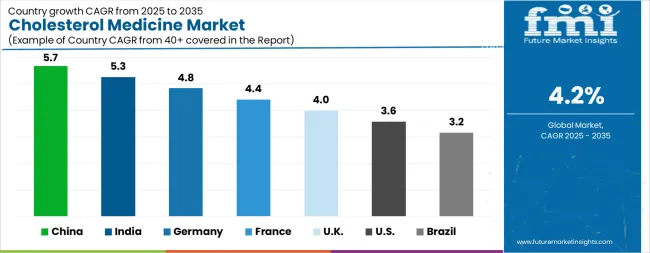
| Country | CAGR |
|---|---|
| China | 5.7% |
| India | 5.3% |
| Germany | 4.8% |
| France | 4.4% |
| UK | 4.0% |
| USA | 3.6% |
| Brazil | 3.2% |
The Cholesterol Medicine Market is expected to register a CAGR of 4.2% during the forecast period, exhibiting varied country level momentum. China leads with the highest CAGR of 5.7%, followed by India at 5.3%. Developed markets such as Germany, France, and the UK continue to expand steadily, while the USA is likely to grow at consistent rates. Brazil posts the lowest CAGR at 3.2%, yet still underscores a broadly positive trajectory for the global Cholesterol Medicine Market. In 2024, Germany held a dominant revenue in the Western Europe market and is expected to grow with a CAGR of 4.8%. The USA Cholesterol Medicine Market is estimated to be valued at USD 12.6 billion in 2025 and is anticipated to reach a valuation of USD 17.9 billion by 2035. Sales are projected to rise at a CAGR of 3.6% over the forecast period between 2025 and 2035. While Japan and South Korea markets are estimated to be valued at USD 1.8 billion and USD 1.1 billion respectively in 2025.
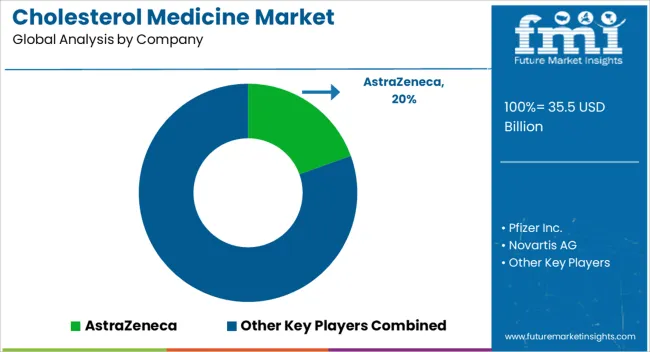
| Item | Value |
|---|---|
| Quantitative Units | USD 35.5 Billion |
| Product Type | HMG-CoA Reductase Inhibitors (Statins), Bile Acid Sequestrants, Fibrates, Niacin, Cholesterol Absorption Inhibitors, Omega-3 Fatty Acid, and Combination Medicines |
| Route Of Administration | Oral and Subcutaneous |
| Distribution Channel | Hospital Pharmacy, Drug Stores, Retail Pharmacy, and E-commerce |
| Regions Covered | North America, Europe, Asia-Pacific, Latin America, Middle East & Africa |
| Country Covered | United States, Canada, Germany, France, United Kingdom, China, Japan, India, Brazil, South Africa |
| Key Companies Profiled | AstraZeneca, Pfizer Inc., Novartis AG, AbbVie Inc., Merck & Co., Inc., Amgen Inc., Dr. Reddy’s Laboratories Ltd., and Sun Pharmaceutical Industries Ltd. |
The global cholesterol medicine market is estimated to be valued at USD 35.5 billion in 2025.
The market size for the cholesterol medicine market is projected to reach USD 53.5 billion by 2035.
The cholesterol medicine market is expected to grow at a 4.2% CAGR between 2025 and 2035.
The key product types in cholesterol medicine market are hmg-coa reductase inhibitors (statins), bile acid sequestrants, fibrates, niacin, cholesterol absorption inhibitors, omega-3 fatty acid and combination medicines.
In terms of route of administration, oral segment to command 61.3% share in the cholesterol medicine market in 2025.






Our Research Products

The "Full Research Suite" delivers actionable market intel, deep dives on markets or technologies, so clients act faster, cut risk, and unlock growth.

The Leaderboard benchmarks and ranks top vendors, classifying them as Established Leaders, Leading Challengers, or Disruptors & Challengers.

Locates where complements amplify value and substitutes erode it, forecasting net impact by horizon

We deliver granular, decision-grade intel: market sizing, 5-year forecasts, pricing, adoption, usage, revenue, and operational KPIs—plus competitor tracking, regulation, and value chains—across 60 countries broadly.

Spot the shifts before they hit your P&L. We track inflection points, adoption curves, pricing moves, and ecosystem plays to show where demand is heading, why it is changing, and what to do next across high-growth markets and disruptive tech

Real-time reads of user behavior. We track shifting priorities, perceptions of today’s and next-gen services, and provider experience, then pace how fast tech moves from trial to adoption, blending buyer, consumer, and channel inputs with social signals (#WhySwitch, #UX).

Partner with our analyst team to build a custom report designed around your business priorities. From analysing market trends to assessing competitors or crafting bespoke datasets, we tailor insights to your needs.
Supplier Intelligence
Discovery & Profiling
Capacity & Footprint
Performance & Risk
Compliance & Governance
Commercial Readiness
Who Supplies Whom
Scorecards & Shortlists
Playbooks & Docs
Category Intelligence
Definition & Scope
Demand & Use Cases
Cost Drivers
Market Structure
Supply Chain Map
Trade & Policy
Operating Norms
Deliverables
Buyer Intelligence
Account Basics
Spend & Scope
Procurement Model
Vendor Requirements
Terms & Policies
Entry Strategy
Pain Points & Triggers
Outputs
Pricing Analysis
Benchmarks
Trends
Should-Cost
Indexation
Landed Cost
Commercial Terms
Deliverables
Brand Analysis
Positioning & Value Prop
Share & Presence
Customer Evidence
Go-to-Market
Digital & Reputation
Compliance & Trust
KPIs & Gaps
Outputs
Full Research Suite comprises of:
Market outlook & trends analysis
Interviews & case studies
Strategic recommendations
Vendor profiles & capabilities analysis
5-year forecasts
8 regions and 60+ country-level data splits
Market segment data splits
12 months of continuous data updates
DELIVERED AS:
PDF EXCEL ONLINE
Cholesterol Esterase Market Size and Share Forecast Outlook 2025 to 2035
Cholesterol and Lipid Test Market Size and Share Forecast Outlook 2025 to 2035
Cholesterol Monitors Market Size and Share Forecast Outlook 2025 to 2035
Cholesterol API Market Analysis - Size, Share, and Forecast 2025 to 2035
Cholesterol Control Supplements Market – Growth, Demand & Health Trends
Cholesterol Reduced Butter Market
HDL Cholesterol Kits Market Size and Share Forecast Outlook 2025 to 2035
Point-of-care Cholesterol Monitoring Device Market Size and Share Forecast Outlook 2025 to 2035
Low-Fat and Low-Cholesterol Diet Market Growth - Health Trends 2025 to 2035
Heterozygous Familial Hypercholesterolemia (HEFH) Management Market Trends - Innovations & Growth 2025 to 2035
Medicine Cabinets Market Size and Share Forecast Outlook 2025 to 2035
Global Medicine Blister Market Analysis – Growth & Forecast 2025 to 2035
Telemedicine Carts Market Size and Share Forecast Outlook 2025 to 2035
Telemedicine Equipment Market Size and Share Forecast Outlook 2025 to 2035
Photomedicine Market
Glass Medicine Bottles Market
Sports Medicine Sutures Market Size and Share Forecast Outlook 2025 to 2035
5G Telemedicine Platform Market Size and Share Forecast Outlook 2025 to 2035
The Sports Medicine Market Is Segmented by Product, Application and End User from 2025 To 2035
Nuclear Medicine Shielded Equipment Market Size and Share Forecast Outlook 2025 to 2035

Thank you!
You will receive an email from our Business Development Manager. Please be sure to check your SPAM/JUNK folder too.
Chat With
MaRIA